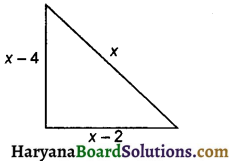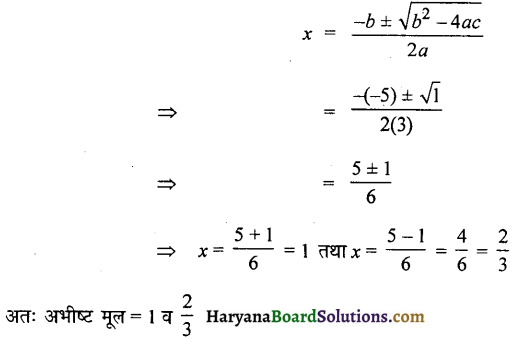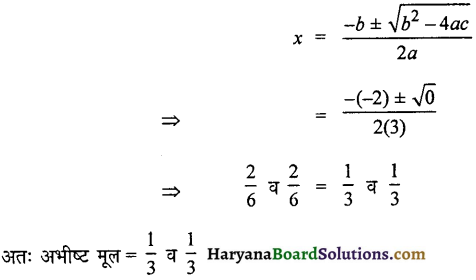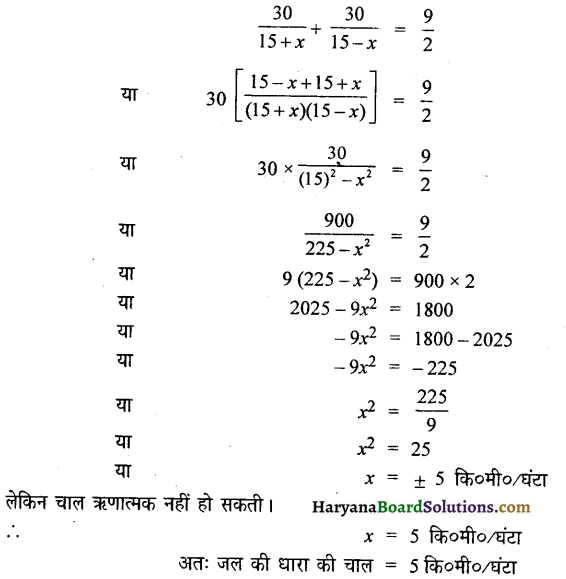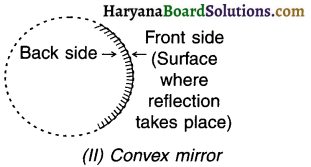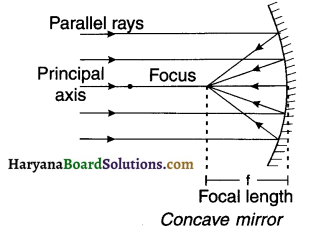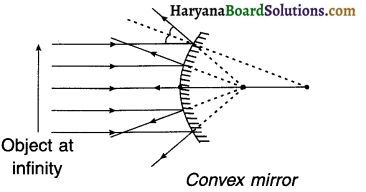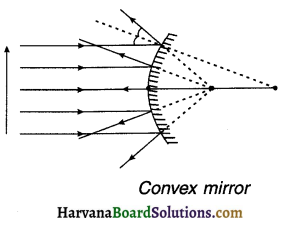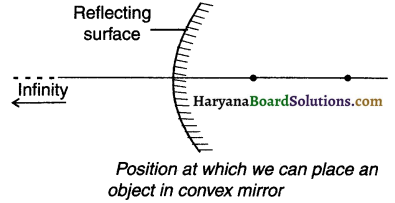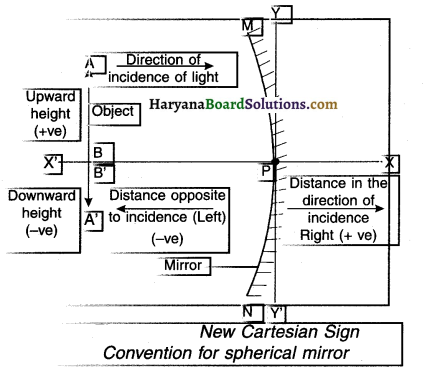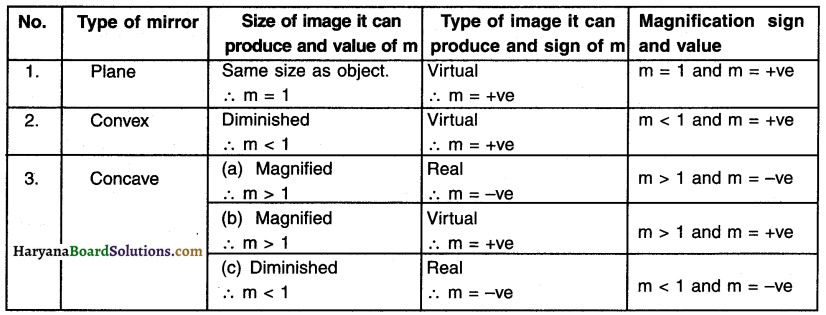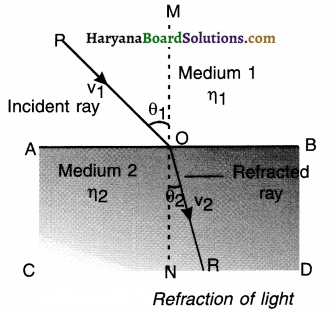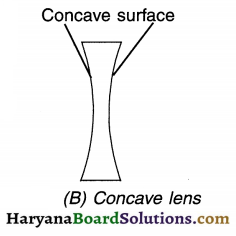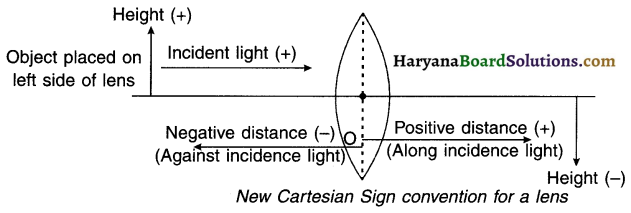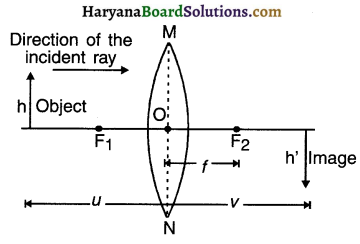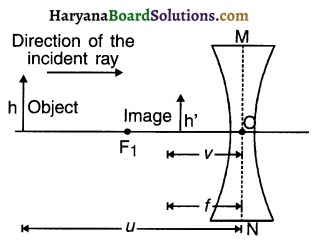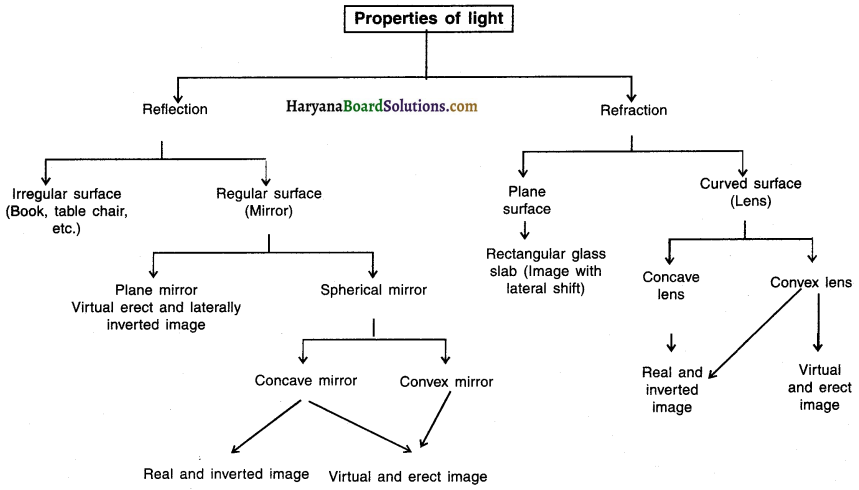HBSE 10th Class Maths Important Questions Chapter 5 समांतर श्रेढ़ियाँ
Haryana State Board HBSE 10th Class Maths Important Questions Chapter 5 समांतर श्रेढ़ियाँ Important Questions and Answers.
Haryana Board 10th Class Maths Important Questions Chapter 5 समांतर श्रेढ़ियाँ
परीक्षोपयोगी अन्य महत्त्वपूर्ण प्रश्न :
प्रश्न 1.
निम्नलिखित AP के लिए प्रथम पद a और सार्व अंतर d लिखिए-
(i) -225, -425, -625, -825,
(ii) \(\frac{3}{2}, \frac{1}{2},-\frac{1}{2},-\frac{3}{2}\), ………………..
हल :
(i) यहाँ पर AP = – 225, – 425, – 625, – 825, ………..
अतः प्रथम पद (a) = – 225
और सार्व अंतर (d) = – 425 – (225)
= – 425 + 225 = – 200
(ii) यहाँ पर AP = \(\frac{3}{2}, \frac{1}{2},-\frac{1}{2},-\frac{3}{2}\), …………….
अतः प्रथम पद (a) = \(\frac{3}{2}\)
और सार्व अंतर (d) = \(\frac{1}{2}-\frac{3}{2}\)
= \(\frac{1-3}{2}\)
= \(\frac{-2}{2}\) = – 1
![]()
प्रश्न 2.
AP का सार्व अंतर ज्ञात कीजिए और उसके अगले दो पद लिखिए-
(i) 51, 59, 67, 75, …………
(ii) 75, 67, 59, 51, ………..
हल :
(i) यहाँ पर
AP = 51, 59, 67, 75, ……….
⇒ प्रथम पद (a1) = 51
सार्व अंतर (d) = 59 – 51 = 8
∴ a5 = a4 + d = 75 + 8 = 83
a6 = a5+ d = 83 + 8 = 91
(ii) यहाँ पर
⇒ प्रथम पद (a1) = 75
सार्व अंतर (d) = 67 – 75 = – 8
∴ a5 = a4 + d = 51 + (-8) = 51 – 8 = 43
a6 = a5 + d = 43 + (-8) = 43 – 8 = 35
प्रश्न 3.
समांतर श्रेढ़ी 2, 4, 6, 8, 10, …………… का 15वाँ पद ज्ञात कीजिए ।
हल :
यहाँ पर दिया गया अनुक्रम है-
2, 4, 6, 8, 10, …….
प्रथम पद (a) = 2
और सार्व अंतर (d) = 4 – 2 = 2
∵ an = a + (n – 1)d
a15 = a + (15 – 1)d
= 2 + 14 × 2
= 2 + 28 = 30
प्रश्न 4.
उस AP का 12 वाँ पद ज्ञात कीजिए जिसका –
(i) प्रथम पद 9 और सार्व अंतर 10 है ।
(ii) प्रथम पद – 20 और सार्व अंतर 4 है ।
हल :
(i) यहाँ पर
प्रथम पद (a) = 9
सार्व अंतर (d) = 10
∴ a12 = a + 11d
= 9 + 11 × 10
= 9 + 110
= 119
(ii) यहाँ पर
प्रथम पद (a) = – 20
सार्व अंतर (d) = 4
∴ a12 = a + 11d
= – 20 + 11 × 4
= – 20 + 44
= 24
प्रश्न 5.
समांतर श्रेढ़ी 7, 3, -1, -5, -9, …………. का n वाँ पद ज्ञात कीजिए ।
हल :
यहाँ पर दिया गया अनुक्रम है-
7, 3, -1, -5, -9, ……….
प्रथम पद (a) = 7
सर्व अंतर (d) = 3 – 7 = – 4
an = a + (n – 1)d
= 7 + (n – 1) (-4)
= 7 – 4n + 4 = 11 – 4n
![]()
प्रश्न 6.
प्रथम 1000 धन – पूर्णांकों का योग ज्ञात कीजिए।
हल :
यहाँ पर प्रथम 1000 धन पूर्णांक = 1, 2, 3, 4, …………, 1000
∴ a = 1
l = 1000
n = 1000
A.P. के प्रथम n पदों का योगफल (Sn) = \(\frac {n}{2}\)(a + l)
⇒ S1000 = \(\frac {1000}{2}\)(1 + 1000)
= 500 × 1001
= 500500
प्रश्न 7.
उस समांतर श्रेढ़ी का पता करें जिसका तीसरा पद 16 और सातवाँ पद 40 है ।
हल :
माना समांतर श्रेढ़ी = a, a + d, a + 2d, …………….
तो an = a + 2d
तथा a7 = a + 6d
प्रश्नानुसार,
a3 = 16
⇒ a + 2d = 16 ………(i)
तथा a7 = 40
⇒ a + 6d = 40 …….(ii)
समीकरण (i) को समीकरण (ii) में से घटाने पर,
4d = 24
या d = \(\frac {24}{4}\) = 6
d का मान समीकरण (i) में रखने पर,
a + 2(6) = 16
या a = 16 – 12 = 4
∵ समांतर श्रेढ़ी का प्रथम पद 4 और इसका सार्व अंतर 6 है ।
∴ समांतर श्रेढ़ी = 4, 10, 16, 22, 28, 34, …………….
प्रश्न 8.
क्या संख्याओं की सूची 5, 11, 17, 23, …………. का कोई पद 301 है, क्यों?
हल :
यहाँ पर सूची = 5, 11, 17, 23, ……………
a2 – a1 = 11 – 5 = 6
a3 – a2 = 17 – 11 = 6
a4 – a3 = 23 – 17 = 6
क्योंकि दो क्रमागत पदों के बीच अंतर समान है, इसलिए दी गई सूची A . P . है ।
⇒ प्रथम पद (a) = 5
सार्व अंतर (d) = 11 – 5 = 6
माना AP का n वाँ पद 301 है तो
an = a + (n – 1)d
301 = 5 + (n – 1) × 6
(n – 1) = \(\frac{301-5}{6}=\frac{296}{6}=\frac{148}{3}\)
n = \(\frac {148}{3}\) + 1 = \(\frac{148+3}{3}=\frac{151}{3}\)
क्योंकि एक धनात्मक पूर्णांक नहीं है, इसलिए दी गई A. P. कोई पद 301 नहीं हो सकता ।
प्रश्न 9.
एक A. P. का 8वाँ पद – 23 है तथा 12वाँ पद – 39 है। A. P. ज्ञात कीजिए ।
हल :
माना A.P. = a, a + d, a + 2d, ……………..
तो a8 = a + 7d
तथा a12 = a + 11d
प्रश्नानुसार,
a8 = – 23
⇒ a + 7d = – 23 (i)
तथा a12 = – 39
⇒ a + 11d = – 39 (ii)
समीकरण (i) को समीकरण (ii) में से घटाने परं
4d = – 16
या d = \(\frac {-16}{4}\) = – 4
d का मान समीकरण (i) में रखने पर
a + 7 (- 4) = – 23
या a = – 23 + 28 = 5
∵ A.P. a = 5 तथा d = – 4
∴ A.P. = 5, 1, -3, -7.
![]()
प्रश्न 10.
किसी AP का प्रथम पद 5 और 100वाँ पद – 292 है । इस A. P. का 50वाँ पद ज्ञात कीजिए ।
हल :
यहाँ पर दी गई समांतर श्रेढ़ी के लिए-
प्रथम पद (a) = 5
100 वाँ पद (a100) = – 292
⇒ a + 99d = – 292
या 5 + 99d = – 292
या 99d = – 292 – 5
या 99d = – 297
या d = \(\frac {- 297}{99}\) = – 3
अतः समांतर श्रेढ़ी का 50 वाँ पद (a50) = a + 49d
= 5 + 49 (-3)
= 5 – 147 = – 142
प्रश्न 11.
उस AP के पहले 50 पदों का योगफल ज्ञात करें जिसका दूसरा पद 14 और 5वाँ पद 26 है।
हल :
माना
AP का प्रथम पद = a
और सार्व अंतर = d
प्रश्नानुसार
a2 = 14
⇒ a + d = 14 …………(i)
तथा a5 = 26
⇒ a + 4d = 26 …………..(ii)
समीकरण (i) को समीकरण (ii) में से घटाने पर,
3d = 12
या d = \(\frac {12}{3}\) = 4
d का मान समीकरण (i) में रखने पर,
a + 4 = 14
या a = 14 – 4 = 10
हम जानते हैं कि
Sn = \(\frac {n}{2}\)[2a + (n – 1)d]
⇒ S50 = \(\frac {50}{2}\)[2(10) + (50 – 1) (4)]
= 25[20 + 196]
= 25 × 216 = 5400
प्रश्न 12.
यदि एक A. P. के पहले 6 पदों का योग 12 और पहले 10 पदों का योग 60 है, तो उस A. P. के n पदों का योग ज्ञात कीजिए ।
हल :
यहाँ पर, A. P. के लिए
S6 = 12
S10 = 60
Sn = ?
हम जानते हैं कि Sn = \(\frac {n}{2}\)[2a + (n – 1)d]
S10 = \(\frac {10}{2}\) [2a + (10 – 1) d]
60 = 5 [2a + 9d] ………..(i)
2a + 9b = 12
तथा S6 = \(\frac {6}{2}\)[2a + (6 – 1)]d
⇒ 12 = 3[2a + 5d]
⇒ 2a + 5d = 4 ……..(ii)
समीकरण (ii) को समीकरण (i) में से घटाने पर,
4d = 8
या d = \(\frac {8}{4}\) = 2
d का मान समीकरण (i) में रखने पर,
2a + 9(2) = 12
या 2a = 12 – 18
या a = \(\frac {-6}{2}\) = – 3
अब Sn = \(\frac {n}{2}\)[2a + (n – 1)d]
= \(\frac {n}{2}\)[2(-3) + (n – 1)(2)]
= \(\frac {n}{2}\)[-6 + 2n – 2]
या Sn = \(\frac {n}{2}\)(2n – 8)
= n2 – 4n
![]()
प्रश्न 13.
समांतर श्रेढ़ी – 4, – 1, 2, 5, 8,………………. के पहले 8 पदों और पदों का योग ज्ञात कीजिए ।
हल :
यहाँ पर दी हुई समांतर श्रेढ़ी है-
-4, -1, 2, 5, 8, ……….
∴ प्रथम पद (a) = – 4
और सार्व अंतर (d) = – 1 – (-4) = – 1 + 4 = 3
हम जानते हैं कि Sn = \(\frac {n}{2}\)[2a + (n – 1)d]
⇒ S8 = \(\frac {8}{2}\)[2(-4) + (8 – 1)(3)]
= 4[-8 + 21]
= 4 × 13 = 52
और S12 = \(\frac {12}{2}\)[2(-4) + (12 – 1)(3)]
= 6[-8 + 33] = 6 × 25 = 150
प्रश्न 14.
योगफल ज्ञात कीजिए प्रथम –
(i) 100 प्राकृत संख्याओं का ।
(ii) n प्राकृत संख्याओं का ।
हल :
(i) यहाँ पर दी हुई समांतर श्रेढ़ी है-
1, 2, 3, 4, …… 100
∴ प्रथम पद (a) = 1
और सार्व अंतर (d) = 2 – 1 = 1
पदों की संख्या (n) = 100
हम जानते हैं कि
Sn = \(\frac {n}{2}\)[2a + (n – 1) d]
⇒ S100 = \(\frac {100}{2}\)[2 × 1 + (100 – 1) × 1]
= 50[2 + 99]
= 50 × 101 = 5050
(ii) यहाँ पर दी हुई समांतर श्रेढ़ी है–
1, 2, 3, 4, ……. n
∴ प्रथम पद (a) = 1
सार्व अंतर (d) = 2 – 1 = 1
पदों की संख्या = n
हम जानते हैं कि
Sn = \(\frac {n}{2}\)[2a + (n – 1) d]
⇒ Sn = \(\frac {n}{2}\)[2 × 1 + (n – 1) (1)]
= \(\frac {n}{2}\)[2 + n – 1]
= \(\frac {n}{2}\)[n + 1]
प्रश्न 15.
दो अंकों वाली कितनी संख्याएँ 3 से विभाज्य हैं?
हल :
हम जानते हैं कि
3 से विभाज्य दो अंकों की सबसे छोटी संख्या = 12
3 से विभाज्य दो अंकों की सबसे बड़ी संख्या = 99
अतः AP = 12, 15, 18, ………….. 99
प्रथम पद (a) = 12
सार्व अंतर (d) = 3
हम जानते हैं कि an = a + (n – 1)d
⇒ 99 = 12 + (n – 1) × 3
⇒ n – 1 = \(\frac{99-12}{3}\)
⇒ n – 1 = \(\frac {87}{3}\)
⇒ n = 29 + 1
⇒ n = 30
अतः दो अंकों वाली 3 से विभाज्य संख्याओं की संख्या = 30
![]()
प्रश्न 16.
योगफल ज्ञात कीजिए – (-5) + (-8) + (-11) + ………………. + (-230)
हल :
यहाँ पर दी हुई समांतर श्रेढ़ी है-
(-5) + (-8) + (-11) + ……… + (-230)
∴ प्रथम पद (a) = – 5
और सार्व अंतर (d) = (-8) – (-5) = – 8 + 5 = – 3
अंतिम पद (l) = – 230
हम जानते हैं कि
l = a + (n – 1) d
⇒ – 230 = 5 + (n – 1) (-3)
या – 230 = – 5 – 3n + 3
या – 230 + 5 – 3 = – 3n
या – 3n = – 228
या n = \(\frac {-228}{-3}\) = 76
अतः Sn = \(\frac {n}{2}\)(a + l)
⇒ S76 = \(\frac {76}{2}\)[- 5 – 230]
= 38 × (- 235) = – 8930
प्रश्न 17.
यदि A. P. के पहले 6 पदों का योग 96 है और पहले 10 पदों का योग 240 है, तो उस A. P. के n पदों का योग ज्ञात कीजिए ।
हल :
यहाँ पर, A. P. के लिए S6 = 96
S10 = 240
Sn = ?
हम जानते हैं कि Sn = \(\frac {n}{2}\)[2a + (n – 1) d]
⇒ S10 = \(\frac {10}{2}\)[2a + (10 – 1)d]
240 = 5[2a + 9d]
2a + 9d = 48 ……………..(i)
तथा S6 = \(\frac {6}{2}\) = 2[2a + (6 – 1)d]
96 = 3[2a +5d]
2a + 5d = 32 ……………..(ii)
समीकरण (ii) को समीकरण (i) में से घटाने पर प्राप्त होता है,
4d = 16
d = \(\frac {16}{4}\) = 4
d का मान समीकरण (i) में प्रतिस्थापित करने पर,
2a + 9(4) = 48
या 2a = 48 – 36
या a = \(\frac {12}{2}\) = 6
अब Sn = \(\frac {n}{2}\)[2a + (n – 1)d]
= \(\frac {n}{2}\)[2(6) + (n – 1)4]
= \(\frac {n}{2}\)[12 + 4n – 4]
= \(\frac {n}{2}\)[4n + 8] = 2n2 + 4n
प्रश्न 18.
यदि A. P. के पहले 10 पदों का योग -60 और पहले 15 पदों का योग -165 है, तो उसके पहले n पदों का योग ज्ञात कीजिए ।
हल :
यहाँ पर, A.P. के लिए
S10 = -60
S15 = -165
Sn = ?
हम जानते हैं कि Sn = \(\frac {n}{2}\)[2a + (n – 1)d]
⇒ S10 = \(\frac {10}{2}\)[2a + (10 – 1)d]
⇒ – 60 = 5[2a + 9d]
⇒ 2a + 9d = – 12 ……………(i)
तथा S15 = \(\frac {15}{2}\)[2a + (15 – 1)d]
⇒ – 165 × \(\frac {2}{15}\) = 2a + 14d
⇒ 2a + 14d = – 22 …………… (ii)
समीकरण (i) को समीकरण (ii) में से घटाने पर प्राप्त होता है,
5d = – 10
या d = – 2
d का मान समीकरण (i) में प्रतिस्थापित करने पर,
2a + 9(-2) = -12
या 2a = – 12 + 18
या 2a = 6
या a = \(\frac {6}{2}\) = 3
अब Sn = \(\frac {n}{2}\)[2a + (n – 1)d]
= \(\frac {n}{2}\)[2(3) + (n – 1)(-2)]
= \(\frac {n}{2}\)[6 – 2n + 2]
= \(\frac {n}{2}\)[8 – 2n]
= 4n – n2
बहुविकल्पीय प्रश्न
प्रश्न 1.
रीना ने एक पद के लिए आवेदन किया और उसका चयन हो गया। उसे यह पद 8000 रु० के मासिक वेतन और 500 रु० वार्षिक की वेतन वृद्धि के साथ दिया गया। इसके लिए (रुपयों में) उचित स मांतर श्रेढ़ी (AP) होगी –
(A) 8000, 8500, 9000, ……..
(B) 8000, 7500, 7000, ……….
(C) 8500, 9000, 9500, ……….
(D) 8500, 8000, 7500, ……….
हल :
(A) 8000, 8500, 9000, ………..
![]()
प्रश्न 2.
एक सीढ़ी के डंडों की लंबाइयाँ नीचे से ऊपर की ओर एक समान रूप से 2cm घटती जाती हैं। सबसे नीचे वाला डंडा लंबाई में 45cm है। नीचे से, पहले, दूसरे, तीसरे, ……. डंडों की लंबाइयाँ (cm में) क्रमशः होगी-
(A) 45, 47, 49, 51, …………..
(B) 45, 43, 41, 39, …………
(C) 45, 41, 37, 33, …………..
(D) 45, 49, 53, 57, ………….
हल :
(B) 45, 43, 41, 39, …………..
प्रश्न 3.
किसी बचत योजना में, कोई धनराशि प्रत्येक 3 वर्षों के बाद स्वयं की \(\frac {5}{4}\) गुनी हो जाती है। 8000 रु० के निवेश की 3, 6, 9 और 12 वर्षों के बाद परिपक्वता राशियाँ (रुपयों में) क्रमशः होंगी-
(A) 10000, 30000, 90000 और 2,70000
(B) 10000, 7500, 5000 और 4000
(C) 10000, 12500, 15625 और 19531.25
(D) उपरोक्त में से कोई नहीं
हल :
(C) 10000, 12500, 15625 और 19531.25
प्रश्न 4.
शकीला अपनी पुत्री की गुल्लक में 100 रु० तब डालती है, जब वह एक वर्ष की हो जाती है तथा प्रत्येक वर्ष इसमें 50 रु० की वृद्धि करती जाती है। उसके पहले, दूसरे, तीसरे, चौथे, ……………. जन्म दिवसों पर उसकी गुल्लक में डाली गई राशियाँ (रुपयों में) क्रमशः होगी-
(A) 200, 250, 300, 350, ………..
(B) 50, 100, 150, 200, ………….
(C) 100, 200, 300, 400, …………
(D) 100, 150, 200, 250, ………..
हल :
(D) 100, 150, 200, 250, …………
प्रश्न 5.
इनमें से कौन-सी A. P. श्रेणी है?
(A) 2, 4, 8, 12, ……..
(B) 0.2, 0.22, 0.222, ……..
(C) – 10, – 6, – 2, 2 ………….
(D) 1, 3, 9, 27, ……..
हल :
(C) – 10, – 6, – 2, 2 ………
![]()
प्रश्न 6.
समांतर श्रेढ़ी 7, 3, – 1, – 5, – 9 का सार्व अंतर है-
(A) 4
(B) – 4
(C) \(\frac {3}{7}\)
(D) \(\frac {7}{3}\)
हल :
(B) – 4
प्रश्न 7.
इनमें से कौन-सी A. P. श्रेणी है?
(A) a, a2, a3, ……………
(B) 12, 32, 52, 72, ………
(C) a, 2a, 3a, 4a, ………….
(D) 1, 3, 9, 27, …………
हल :
(C) a, 2a, 3a, 4a, ……..
प्रश्न 8.
समांतर श्रेढ़ी 12, 2, – 8, – 18 ………. का सार्व अंतर है-
(A) -10
(B) 10
(C) \(\frac {3}{7}\)
(D) – 4
हल :
(A) – 10
![]()
प्रश्न 9.
निम्नलिखित में से कौन-सा क्रम समांतर श्रेढ़ी में नहीं है ?
(A) 3, 3, 3, 3, ……..
(B) 2, 2, 2, 2, ………..
(C) 3, 5, 8, 12, 20, ………
(D) 5, 5, 5, 5, ………..
हल :
(C) 3, 5, 8, 12, 20 ……..
प्रश्न 10.
एक समांतर श्रेढ़ी संख्याओं की एक ऐसी सूची होती है जिसमें प्रत्येक पद (पहले पद के अतिरिक्त) अपने पद में एक …………. संख्या जोड़ने पर प्राप्त होता है ।
(A) निश्चित
(B) विषम
(C) सम
(D) अभाज्य
हल :
(A) निश्चित
प्रश्न 11.
एक समांतर श्रेढ़ी संख्याओं की एक ऐसी सूची होती है जिसमें प्रत्येक पद (पहले पद के अतिरिक्त) अपने पद में एक निश्चित संख्या जोड़ने पर प्राप्त होता है । यह निश्चित संख्या AP का क्या कहलाती है?
(A) प्रथम पद
(B) अंतिम पद
(C) सार्व अंतर
(D) n वाँ पद
हल :
(C) सार्व अंतर
![]()
प्रश्न 12.
प्रथम पद a तथा सार्व अंतर d वाली समांतर श्रेढ़ी का n वाँ पद होगा-
(A) \(\frac {n}{2}\)(a + l)
(B) a + (n – 1)d
(C) d + (n – 1)a
(D) \(\frac {n}{2}\)(a + d)
हल :
(B) a + (n – 1) d
प्रश्न 13.
समांतर श्रेढ़ी – 5 – 1, 3, 7 का सार्व अंतर है-
(A) – 4
(B) 4
(C) 6
(D) इनमें से कोई नहीं
हल :
(B) 4
प्रश्न 14.
समांतर श्रेढ़ी p, p + 90, p + 180, p + 270, ……… [ जहाँ p = (999)999] का सार्व अंतर है –
(A) 90
(B) – 90
(C) p
(D) शून्य
हल :
(A) 90
![]()
प्रश्न 15.
समांतर श्रेढ़ी – 125, – 325, – 525, – 725 ………… का सार्व अंतर है-
(A) – 125
(B) 125
(C) 200
(D) – 200
हल :
(D) – 200
प्रश्न 16.
प्रथम पद f तथा सार्व अंतर d वाली समांतर श्रेढ़ी का p वाँ पद होगा-
(A) f + (n – 1) d
(B) \(\frac {n}{2}\) (f + d)
(C) d + (p – 1) f
(D) f + (p – 1) d
हल :
(D) f + (p – 1 ) d
प्रश्न 17.
समांतर श्रेढ़ी 2.8, 3.0, 3.2, 3.4, …………. के अगले दो पद होंगे-
(A) 3.8 व 4.0
(B) 2.8 व 3.0
(C) 3.0 व 3.2
(D) 3.6 व 3.8
हल :
(D) 3.6 व 3.8
प्रश्न 18.
उस समांतर श्रेढ़ी (AP) के प्रथम 51 पदों का योगफल क्या होगा जिसके दूसरे और तीसरे पद क्रमशः 14 और 18 हैं?
(A) 5410
(B) 5510
(C) 5610
(D) 5710
हल :
(C) 5610
![]()
प्रश्न 19.
A.P. 13, 15\(\frac {1}{2}\), 18, 20\(\frac {1}{2}\), ……………. का 11वाँ पद है :
(A) 38
(B) 40\(\frac {1}{2}\)
(C) 43
(D) 45\(\frac {1}{2}\)
हल :
(A) 38
प्रश्न 20.
समांतर श्रेढ़ी 10.0, 10.5, 11.0, 11.5, …………… का 10वाँ पद होगा-
(A) 15.5
(B) 14.0
(C) 14.5
(D) 15.0
हल :
(C) 14.5
प्रश्न 21.
यदि एक समांतर श्रेढ़ी में Sn = 256, a = 1 और d = 2 तो n का मान होगा-
(A) 18
(B) 14
(C) 15
(D) 16
हल :
(D) 16
![]()
प्रश्न 22.
यदि A.P. का तीसरा पद 5 और 7 वाँ पद 13 है, तो उसका सार्व अंतर (common difference) है :
(A) 1
(B) 2
(C) 3
(D) 4
हल :
(D) 16
प्रश्न 23.
समांतर श्रेढ़ी (A.P.) – 11, – 7, – 3, ……………….. का सार्व अन्तर (common difference) है-
(A) 4
(B) – 4
(C) – 11
(D) – 18
हल :
(A) 4
प्रश्न 24.
A.P. 5, 6\(\frac {1}{2}\), 8, 9\(\frac {1}{2}\), ……………. का 15 वाँ पद है :
(A) 15\(\frac {1}{2}\)
(B) 14\(\frac {1}{2}\)
(C) 26
(D) 27\(\frac {1}{2}\)
हल :
(C) 26
प्रश्न 25.
समांतर श्रेढ़ी 4, 10, 16, 22, ……………. के अगले दो पद होंगे-
(A) 26 व 32
(B) 28 व 34
(C) 34 व 40
(D) 28 व 32
हल :
(B) 28 व 34
![]()
प्रश्न 26.
समांतर श्रेढ़ी 1, – 1, – 3, – 5, ………………. के अगले दो पद होंगे-
(A) – 7 व – 9
(B) – 7 व – 8
(C) – 9 व – 11
(D) – 7 व – 11
हल :
(A) – 7 व – 9
प्रश्न 27.
संख्याओं की निम्नलिखित सूची में से कौन-सी सूची AP नहीं है ?
(A) 2, 8, 14, 20, …………….
(B) 1, 2, 3, 4, ……………..
(C) 2, 2, 2, 2, ……………..
(D) 1, 1, 2, 2, 3, 3, …………..
हल :
(D) 1, 1, 2, 2, 3, 3, …………..
प्रश्न 28.
यदि एक A.P. का तीसरा पद 12 और 10 वाँ पद 26 है, तो उसका 20वाँ पद है :
(A) 46
(B) 52
(C) 50
(D) 44
हल :
(A) 46
प्रश्न 29.
प्रथम पद 4 तथा सार्व अंतर – 3 वाली AP के प्रथम दो पद होंगे-
(A) 4 व 1
(B) 4 व 7
(C) 4 व – 2
(D) 4 व 10
हल :
(A) 4 व 1
प्रश्न 30.
प्रथम पद – 2 तथा सार्व अंतर 0 वाली AP के प्रथम चार पद होंगे-
(A) -2, -4, -6, -8
(B) -2, -2, -2, -2
(C) -2, 0, 2, 4
(D) 0, 0, 0, 0
हल :
(B) -2, -2, -2, -2
![]()
प्रश्न 31.
AP : 3, 1, – 1, – 3, ………. के प्रथम पद व सार्व अंतर क्रमशः होंगे-
(A) 3 व 2
(B) 3 व 4
(C) 3 व – 2
(D) – 2 व 3
हल :
(C) 3 व – 2
प्रश्न 32.
A.P. 0.6, 1.7, 2.8, 3.9, …………… का 14 वाँ पद है :
(A) 14.9
(B) 16.0
(C) 17.1
(D) 18.2
हल :
(A) 14.9
प्रश्न 33.
दी हुई A. P. का a = 10 तथा d = 10 है, तो इस A. P. का द्वितीय पद ……………. है ।
(A) 10
(B) 20
(C) 30
(D) 40
हल :
(B) 20
प्रश्न 34.
AP : \(\sqrt{m}\), \(\sqrt{m}\), \(\sqrt{m}\), \(\sqrt{m}\), ………… का सार्व अंतर होगा-
(A) \(\sqrt{6}\)
(B) 2
(C) \(\sqrt{2}\)
(D) \(\sqrt{4}\)
हल :
(C) \(\sqrt{2}\)
![]()
प्रश्न 35.
A. P. 13, 15\(\frac {1}{2}\), 18, 20\(\frac {1}{2}\), …………… का 11 वाँ पद है :
(A) 38
(B) 40\(\frac {1}{2}\)
(C) 43
(D) 45\(\frac {1}{2}\)
हल :
(A) 38
प्रश्न 36.
यदि किसी A. P. का तीसरा पद 4 और 9वाँ पद – 8 है, तो उनका सार्व अंतर (common difference) है :
(A) – 2
(B) 2
(C) 4
(D) – 8
हल :
(A) – 2
प्रश्न 37.
यदि किसी समांतर श्रेढ़ी (AP) का प्रथम पद \(\frac {1}{2}\) और सार्व अंतर \(\frac {1}{12}\) हो तो उसका 12 वाँ पद होगा-
(A) \(\frac {17}{12}\)
(B) \(\frac {15}{12}\)
(C) \(\frac {16}{12}\)
(D) \(\frac {13}{12}\)
हल :
(A) \(\frac {17}{12}\)
प्रश्न 38.
\(\frac{1}{3}, \frac{5}{3}, \frac{9}{3}, \frac{13}{3}\) …………….. A. P. के लिए, निम्न से सार्वअन्तर ज्ञात कीजिए ।
(A) \(\frac {-4}{3}\)
(B) \(\frac {2}{3}\)
(C) \(\frac {4}{3}\)
(D) इनमें से कोई नहीं
हल :
(C) \(\frac {4}{3}\)
![]()
प्रश्न 39.
-0.1, -0.2, -0.3, …………… A. P. का 10वा पद हैं-
(A) – 0.9
(B) – 0.8
(C) – 1.0
(D) – 1.1
हल :
(C) – 1.0
प्रश्न 40.
A. P. 2, 7, 12, ………. का 10वाँ पद है-
(A) -47
(B) 47
(C) 57
(D) इनमें से कोई नहीं
हल :
(B) 47
प्रश्न 41.
दी हुई A. P. का a = – 2 तथा d = 0 है, तो इस A. P. का द्वितीय पद ……………. है-
(A) – 2
(B) 0
(C) 2
(D) 4
हल :
(A) – 2
![]()
प्रश्न 42.
A.P. – 10, – 6, – 2, 2, …………… का 20वाँ पद है :
(A) 66
(B) – 66
(C) 77
(D) इनमें से कोई नहीं
हल :
(A) 66
प्रश्न 43.
यदि 11, x, 5 किसी AP के पद हों तो x का मान होगा-
(A) 6
(B) 7
(C) 8
(D) 9
हल :
(C) 8
प्रश्न 44.
A.P. \(\frac{1}{3}, \frac{5}{3}, \frac{9}{3}, \frac{13}{3}\), ……………. का 15 वाँ पद है :
(A) \(\frac {61}{3}\)
(B) 6
(C) 5
(D) 19
हल :
(D) 19
प्रश्न 45.
समांतर श्रेढ़ी 18, 15 \(\frac {1}{2}\), 13, ………. – 47 में पदों की संख्या होगी-
(A) 27
(B) 28
(C) 29
(D) 30
हल :
(A) 27
प्रश्न 46.
दी हुई A. P. का a = 4 तथा d = – 3 है, तो इस A. P. का द्वितीय पद ……………… है :
(A) 4
(B) 1
(C) – 2
(D) – 5
हल :
(B) 1
![]()
प्रश्न 47.
समांतर श्रेढ़ी 25, 50, 75, 100, …………. का कौन-सा पद 1000 होगा ?
(A) 37वाँ
(B) 38वाँ
(C) 39वाँ
(D) 40वाँ
हल :
(D) 40वाँ
प्रश्न 48.
34 + 32 + 30 +…………………+ 10 का मान है :
(A) 294
(B) 289
(C) 286
(D) 386
हल :
(C) 286
प्रश्न 49.
समांतर श्रेढ़ी (AP) – 6, 0, 6, ……………. के प्रथम 13 पदों का योगफल होगा-
(A) 390
(B) 396
(C) 402
(D) 408
हल :
(A) 390
प्रश्न 50.
2 + 4 + 6 + …….. + 200 का योगफल होगा-
(A) 1010
(B) 10100
(C) 101000
(D) 101
हल :
(B) 10100
प्रश्न 51.
(-5) + (-8) + (-11) + …… + (-230) का योगफल होगा-
(A) -8730
(B) -8830
(C) -8930
(D) -9030
हल :
(C) – 8930
![]()
प्रश्न 52.
प्रथम 100 प्राकृत संख्याओं का योगफल होगा-
(A) 5050
(B) 4950
(C) 5150
(D) 5250
हल :
(A) 5050
प्रश्न 53.
यदि किसी AP का प्रथम पद a तथा सार्व अंतर d हो तो इसके n पदों का योग होगा-
(A) \(\frac {n}{2}\)[a + (n – 1)d]
(B) \(\frac {n}{2}\)[2a + (n – 1)d]
(C) \(\frac {n}{2}\)[4a+ (n – 1)d]
(D) \(\frac {n}{2}\)[3a + (n – 1)d]
हल :
(B) \(\frac {n}{2}\)[2a + (n – 1)d]
प्रश्न 54.
AP : 8, 3, -2, …………. के प्रथम 22 पदों का योग होगा-
(A) – 969
(B) – 974
(C) – 979
(D) – 984
हल :
(C) – 979
प्रश्न 55.
प्रथम n धन पूर्णांकों का योग होगा-
(A) \(\frac{(n-1)(n+1)}{2}\)
(B) \(\frac{n(n-1)}{2}\)
(C) \(\frac{n(n+2)}{2}\)
(D) \(\frac{n(n+1)}{2}\)
हल :
(D) \(\frac{n(n+1)}{2}\)
प्रश्न 56.
(A) – 24
(B) – 30
(C) – 36
(D) – 42
हल :
(B) – 30
![]()
प्रश्न 57.
किसी अनुक्रम का n वाँ पद 9 – 5n है,
(A) 4, – 1, – 6, – 11, ……….
(B) 5, 4, 3, 2, 1, …………..
(C) 7, 9, 11, 13, ………….
(D) 7, 11, 15, ……………
हल :
(A) 4, – 1, – 6, – 11, ……….
प्रश्न 58.
यदि किसी समांतर श्रेढ़ी का 9वाँ तथा 5वाँ पद क्रमशः 28 और
16 हो तो इस श्रेढ़ी के 15 पदों का योग होगा-
(A) 325
(B) 350
(C) 375
(D) 400
हल :
(C) 375
प्रश्न 59.
किसी AP का सार्व अंतर वही जो एक अन्य AP का, इनमें से एक का प्रथम पद 3 और दूसरी का 8 है । इनके चौथे पदों में अंतर होगा-
(A) 3
(B) 11
(C) 5
(D) 4
हल :
(C) 5
प्रश्न 60.
प्रथम पद f और अंतिम पद l वाली समांतर श्रेढ़ी के m पदों का योगफल होगा-
(A) \(\frac {l}{2}\)(m + f)
(B) \(\frac {m}{2}\)(f + l)
(C) \(\frac {f}{2}\) (m + l)
(D) f + (m – 1)l
हल :
(B) \(\frac {m}{2}\)(f + l)
प्रश्न 61.
यदि किसी AP में a = 5, d = 3, an = 50 ह्ये तो n का मान होगा-
(A) 16
(B) 15
(C) 17
(D) 18
हल :
(A) 16
![]()
प्रश्न 62.
यदि किसी AP में a12 = 37 व d = 3 हो तो a का मान होगा-
(A) 6
(B) 5
(C) 4
(D) 3
हल :
(C) 4
प्रश्न 63.
यदि किसी AP में a = 8, an = 62, n = 6 हो तो d का मान होगा-
(A) \(\frac {51}{5}\)
(B) \(\frac {52}{5}\)
(C) \(\frac {53}{5}\)
(D) \(\frac {54}{5}\)
हल :
(D) \(\frac {54}{5}\)
प्रश्न 64.
अनुक्रम an = 3n + 2 का तीसरा पद होगा-
(A) 8
(B) 11
(C) 14
(D) 17
हल :
(B) 11
प्रश्न 65.
अनुक्रम an = (-1)n-1 . 2n का चौथा पद होगा-
(A) 8
(B) – 8
(C) – 16
(D) 16
हल :
(C) – 16
HBSE 10th Class Maths Important Questions Chapter 5 समांतर श्रेढ़ियाँ Read More »
